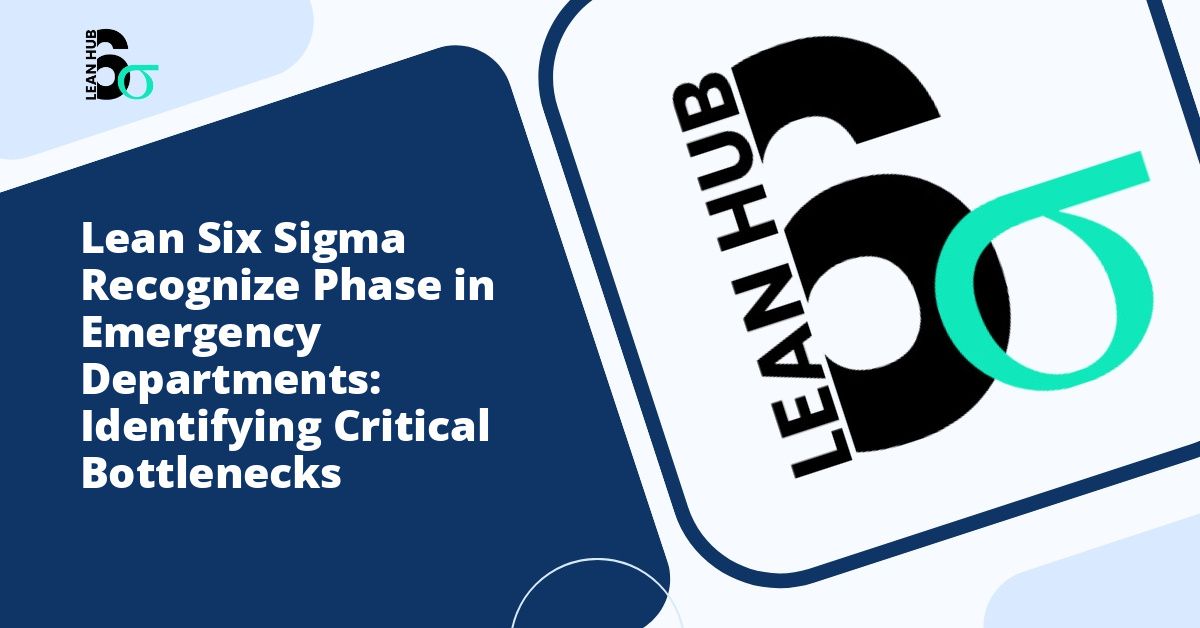Emergency departments serve as the critical first point of contact for patients requiring urgent medical care. However, these vital healthcare facilities often struggle with overcrowding, extended wait times, and operational inefficiencies that can compromise patient outcomes. Implementing the lean six sigma methodology, particularly the recognize phase, offers a structured approach to identifying and addressing these critical bottlenecks that hinder optimal emergency department performance.
Understanding Lean Six Sigma in Healthcare Settings
Lean six sigma represents a powerful combination of two proven methodologies: Lean, which focuses on eliminating waste and improving flow, and Six Sigma, which emphasizes reducing variation and defects through data-driven decision making. When applied to emergency departments, this integrated approach helps healthcare administrators and clinical staff systematically identify problems, measure performance, and implement sustainable improvements. You might also enjoy reading about Stakeholder Analysis: Who Needs to be Involved in Problem Recognition?.
The recognize phase forms the foundation of any lean six sigma project. This initial stage involves identifying problems, understanding their scope, and establishing a clear project direction. In emergency departments, where every minute counts and resources are constantly stretched, the recognize phase becomes particularly crucial for prioritizing which bottlenecks require immediate attention. You might also enjoy reading about Agile and Six Sigma: Mastering Problem Recognition in Hybrid Methodologies.
Common Bottlenecks in Emergency Departments
Before diving into the recognize phase process, it helps to understand the typical bottlenecks that plague emergency departments across healthcare systems. These obstacles can significantly impact patient satisfaction, clinical outcomes, and overall departmental efficiency. You might also enjoy reading about Creating a Problem Recognition Culture in Your Organization: A Strategic Approach to Continuous Improvement.
Patient Registration and Triage Delays
The initial point of contact often creates the first bottleneck. When registration processes are cumbersome or triage protocols are unclear, patients experience unnecessary delays before receiving care. Complex paperwork, inefficient data entry systems, and insufficient staffing during peak hours contribute to these early-stage bottlenecks.
Diagnostic Testing Turnaround Times
Laboratory tests, imaging studies, and specialist consultations frequently create significant delays in the patient care continuum. When test results take hours to return or imaging equipment has limited availability, patients remain in emergency department beds longer than necessary, creating downstream congestion.
Bed Availability and Patient Flow
Perhaps the most visible bottleneck in emergency departments involves the lack of available beds, both within the emergency department itself and in inpatient units. When admitted patients cannot transfer to appropriate hospital beds, they board in emergency department spaces, limiting capacity for new arrivals and creating dangerous overcrowding situations.
Discharge and Admission Processes
The final stages of emergency department care often experience significant delays. Slow discharge processes, waiting for specialist approval for admissions, and coordination with inpatient units can keep patients in the emergency department far longer than medically necessary.
Implementing the Recognize Phase in Emergency Departments
The recognize phase follows a systematic approach to identify and prioritize bottlenecks. This structured methodology ensures that improvement efforts focus on the most critical issues affecting patient care and operational efficiency.
Stakeholder Engagement and Team Formation
Successful implementation of the recognize phase begins with assembling the right team. This cross-functional group should include emergency department physicians, nurses, administrative staff, laboratory and imaging representatives, and patient advocates. Each stakeholder brings unique perspectives on where bottlenecks occur and how they impact different aspects of emergency department operations.
Engaging frontline staff proves particularly valuable, as these team members interact directly with bottlenecks daily and often possess valuable insights that may not be apparent from administrative data alone. Creating a culture where staff feel comfortable identifying problems without fear of blame becomes essential for honest recognition of existing bottlenecks.
Data Collection and Analysis
The recognize phase relies heavily on data to identify and quantify bottlenecks. Emergency departments should gather both quantitative metrics and qualitative observations to build a comprehensive picture of operational challenges.
Key performance indicators to track include:
- Door-to-doctor time (how long patients wait before seeing a physician)
- Length of stay for different patient categories
- Left without being seen rates
- Diagnostic test turnaround times
- Boarding times for admitted patients
- Patient satisfaction scores
- Staff overtime hours and burnout indicators
Beyond numerical data, the recognize phase should incorporate direct observations, staff interviews, and patient feedback. Walking through the patient journey from arrival to discharge helps identify bottlenecks that might not be apparent from data alone. Time studies, process mapping, and value stream analysis provide visual representations of where delays and inefficiencies occur.
Prioritizing Bottlenecks Using Impact Assessment
Not all bottlenecks carry equal weight. The recognize phase must include a systematic method for prioritizing which problems to address first. This prioritization typically considers several factors:
Patient Safety Impact: Bottlenecks that pose immediate risks to patient safety should receive top priority. Delays in treating time-sensitive conditions like strokes or heart attacks require immediate attention.
Frequency and Scope: Problems affecting large numbers of patients or occurring consistently throughout the day warrant higher priority than isolated incidents.
Resource Requirements: Some bottlenecks can be addressed with relatively minor changes, while others require significant investment. The recognize phase should identify quick wins alongside longer-term improvement opportunities.
Measurability: Bottlenecks that can be clearly measured and tracked provide better opportunities for demonstrating improvement and maintaining momentum.
Root Cause Analysis Techniques
Once bottlenecks are identified and prioritized, the recognize phase employs various analytical tools to understand underlying causes. The five whys technique involves asking “why” repeatedly until the fundamental cause emerges. Fishbone diagrams help categorize potential causes into groups such as people, processes, equipment, environment, and materials.
For example, if laboratory test turnaround time is identified as a critical bottleneck, asking why repeatedly might reveal that the root cause is not laboratory processing speed, but rather unclear ordering protocols that result in frequent test cancellations and reorders.
Creating a Project Charter
The recognize phase culminates in developing a project charter that documents the identified bottleneck, its impact, the proposed scope of the improvement project, and success metrics. This charter serves as the roadmap for subsequent phases of the lean six sigma methodology.
A well-crafted project charter for an emergency department bottleneck should include a clear problem statement, quantifiable goals, defined team roles, project timeline, and resource requirements. This document ensures alignment among stakeholders and provides a reference point for measuring progress.
Challenges in the Recognize Phase
Implementing the recognize phase in emergency departments presents unique challenges. The fast-paced, unpredictable nature of emergency care makes data collection difficult. Staff resistance to change, particularly among experienced clinicians comfortable with existing workflows, can hinder honest identification of problems.
Additionally, emergency departments operate as part of larger hospital systems, meaning some bottlenecks originate from departments outside emergency medicine control. Recognizing these system-level issues while defining achievable project scopes requires careful navigation.
Success Factors for Effective Recognition
Several factors contribute to successful implementation of the recognize phase in emergency departments. Leadership support from both administrative and clinical leaders legitimizes improvement efforts and allocates necessary resources. Transparent communication about the purpose of the recognize phase helps overcome staff concerns about blame or job security.
Starting with pilot projects in specific areas rather than attempting wholesale transformation allows teams to demonstrate success and build momentum. Celebrating small wins during the recognize phase maintains enthusiasm and engagement for the longer improvement journey ahead.
Conclusion
The recognize phase of lean six sigma provides emergency departments with a systematic framework for identifying and prioritizing the critical bottlenecks that impede efficient, high-quality patient care. By engaging stakeholders, collecting comprehensive data, and employing structured analytical tools, healthcare organizations can move beyond anecdotal complaints to evidence-based understanding of their operational challenges.
While the recognize phase requires time and resources, this investment pays dividends throughout the improvement process. A thorough recognition of bottlenecks ensures that subsequent efforts focus on the right problems, increasing the likelihood of meaningful, sustainable improvements in emergency department performance. As healthcare systems face increasing pressure to deliver better outcomes with limited resources, the disciplined approach of lean six sigma recognition becomes not just beneficial, but essential for emergency department success.








